Influence of Meander Confinement on Hydro-Morphodynamics of a Cohesive Meandering Channel
Abstract
:1. Introduction
1.1. Background
1.2. Objectives and Structure
2. Methodology
2.1. Study Site
2.2. Site Reconnaissance
2.2.1. M4 Sampling Reach
2.2.2. M3 Sampling Reach
2.3. Data Collection and Analysis
3. Results
4. Discussion
5. Conclusions
Acknowledgments
Author Contributions
Conflicts of Interest
References
- Thomson, J. On the origin of windings of rivers in alluvial plains, with remarks on the flow of water round bends in pipes. Proc. R. Soc. Lond. 1876, 25, 5–8. [Google Scholar] [CrossRef]
- Einstein, A. The Cause of the Formation of Meanders in the Courses of Rivers and of the So-Called Baer’s Law. Die Naturwiss. 1926, 14, 223–224. [Google Scholar] [CrossRef]
- Bridge, J.S.; Jarvis, J. Flow and sedimentary processes in the meandering river South Esk, Glen Clova, Scotland. Earth Surf. Process. Landf. 1976, 1, 303–336. [Google Scholar] [CrossRef]
- Thompson, A. Secondary flows and the pool-riffle unit: A case study of the processes of meander development. Earth Surf. Process. Landf. 1986, 11, 631–641. [Google Scholar] [CrossRef]
- Ikeda, S.; Parker, G. (Eds.) River Meandering; American Geophysical Union: Washington, DC, USA, 1989. [Google Scholar]
- Demuren, A.O. A numerical model for flow in meandering channels with natural bed topography. Water Resour. Res. 1993, 29, 1269–1277. [Google Scholar] [CrossRef]
- Blanckaert, K.; de Vriend, H.J. Nonlinear modeling of mean flow redistribution in curved open channels. Water Resour. Res. 2003, 39. [Google Scholar] [CrossRef]
- Lanzoni, S.; Seminara, G. On the nature of meander instability. J. Geophys. Res. Earth Surf. 2006, 111. [Google Scholar] [CrossRef]
- Alam, J.B.; Uddin, M.; Ahmed, U.J.; Cacovean, H.; Rahman, H.M.; Banik, B.K.; Yesmin, N. Study of morphological change of river old Brahmaputra and its social impacts by remote sensing. Geogr. Tech. 2007, 2, 1–11. [Google Scholar]
- Alam, J.B.; Uddin, M.; Ahmed, J.U.; Rahman, M.H.; Banik, B.K.; Yesmin, N.; Islam, M. Study of the morphological change of the river old Brahmaputra and its impacts. Asian J. Water Environ. Pollut. 2009, 6, 11–19. [Google Scholar]
- Blanckaert, K. Hydrodynamic processes in sharp meander bends and their morphological implications. J. Geophys. Res. Earth Surf. 2011, 116. [Google Scholar] [CrossRef]
- Kasvi, E.; Vaaja, M.; Alho, P.; Hyyppä, H.; Hyyppä, J.; Kaartinen, H.; Kukko, A. Morphological changes on meander point bars associated with flow structure at different discharges. Earth Surf. Process. Landf. 2013, 38, 577–590. [Google Scholar] [CrossRef]
- Asahi, K.; Shimizu, Y.; Nelson, J.; Parker, G. Numerical simulation of river meandering with self-evolving banks. J. Geophys. Res. Earth Surf. 2013, 118, 2208–2229. [Google Scholar] [CrossRef]
- Kasvi, E.; Vaaja, M.; Kaartinen, H.; Kukko, A.; Jaakkola, A.; Flener, C.; Hyyppä, H.; Hyyppä, J.; Alho, P. Sub-bend scale flow–sediment interaction of meander bends—A combined approach of field observations, close-range remote sensing and computational modelling. Geomorphology 2015, 238, 119–134. [Google Scholar] [CrossRef]
- Parsapour-Moghaddam, P.; Rennie, C.D. Hydrostatic versus nonhydrostatic hydrodynamic modelling of secondary flow in a tortuously Meandering River: Application of Delft3D. River Res. Appl. 2017, 33, 1400–1410. [Google Scholar] [CrossRef]
- Parsapour-Moghaddam, P.; Rennie, C.D. Calibration of a 3D Hydrodynamic Meandering River Model Using Fully Spatially Distributed 3D ADCP Velocity Data. J. Hydraul. Eng. 2018, 144, 04018010. [Google Scholar]
- Schuurman, F.; Shimizu, Y.; Iwasaki, T.; Kleinhans, M.G. Dynamic meandering in response to upstream perturbations and floodplain formation. Geomorphology 2016, 253, 94–109. [Google Scholar] [CrossRef]
- Hooke, J. River meander behaviour and instability: A framework for analysis. Trans. Inst. Br. Geogr. 2003, 28, 238–253. [Google Scholar] [CrossRef]
- Hodskinson, A.; Ferguson, R.I. Numerical modelling of separated flow in river bends: Model testing and experimental investigation of geometric controls on the extent of flow separation at the concave bank. Hydrol. Process. 1998, 12, 1323–1338. [Google Scholar] [CrossRef]
- Ferguson, R.I.; Parsons, D.R.; Lane, S.N.; Hardy, R.J. Flow in meander bends with recirculation at the inner bank. Water Resour. Res. 2003, 39. [Google Scholar] [CrossRef] [Green Version]
- Blanckaert, K.; Kleinhans, M.G.; McLelland, S.J.; Uijttewaal, W.S.; Murphy, B.J.; van de Kruijs, A.; Parsons, D.R. Flow Separation and Morphology in Sharp Meander Bends. In Proceedings of the AGU Fall Meeting, San Francisco, CA, USA, 13–17 December 2010; American Geophysical Union: Washington, DC, USA, 2010. [Google Scholar]
- Constantinescu, G.; Kashyap, S.; Tokyay, T.; Rennie, C.D.; Townsend, R.D. Hydrodynamic processes and sediment erosion mechanisms in an open channel bend of strong curvature with deformed bathymetry. J. Geophys. Res. Earth Surf. 2013, 118, 480–496. [Google Scholar] [CrossRef]
- Blanckaert, K.; Kleinhans, M.G.; McLelland, S.J.; Uijttewaal, W.S.; Murphy, B.J.; Kruijs, A.; Parsons, A.; Chen, Q. Flow separation at the inner (convex) and outer (concave) banks of constant-width and widening open-channel bends. Earth Surf. Process. Landf. 2013, 38, 696–716. [Google Scholar] [CrossRef]
- Nardi, L.; Campo, L.; Rinaldi, M. Quantification of riverbank erosion and application in risk analysis. Nat. Hazards 2013, 69, 869–887. [Google Scholar] [CrossRef]
- Rinaldi, M.; Casagli, N.; Dapporto, S.; Gargini, A. Monitoring and modelling of pore water pressure changes and riverbank stability during flow events. Earth Surf. Process. Landf. 2004, 29, 237–254. [Google Scholar] [CrossRef]
- Simon, A.; Collison, A.J. Pore-water pressure effects on the detachment of cohesive streambeds: Seepage forces and matric suction. Earth Surf. Process. Landf. 2001, 26, 1421–1442. [Google Scholar] [CrossRef]
- Pizzuto, J. An empirical model of event scale cohesive bank profile evolution. Earth Surf. Process. Landf. 2009, 34, 1234–1244. [Google Scholar] [CrossRef]
- Salem, H.; Rennie, C.D. Practical determination of critical shear in cohesive soils. J. Hydraul. Eng. (ASCE) 2017, 143, 04017045. [Google Scholar] [CrossRef]
- Eke, E.; Parker, G.; Shimizu, Y. Numerical modeling of erosional and depositional bank processes in migrating river bends with self-formed width: Morphodynamics of bar push and bank pull. J. Geophys. Res. Earth Surf. 2014, 119, 1455–1483. [Google Scholar] [CrossRef]
- Casagli, N.; Curini, A.; Gargini, A.; Rinaldi, M.; Simon, A. Effects of pore pressure on the stability of streambanks: Preliminary results from the Sieve River, Italy. In Proceedings of the Management of Landscapes Disturbed by Channel Incision, Oxford, MS, USA, 19–23 May 1997; pp. 243–248. [Google Scholar]
- Simon, A.; Curini, A. Pore pressure and bank stability: The influence of matric suction. In Proceedings of the Water Resources Engineering 98, Memphis, TN, USA, 3–7 August 1998; pp. 358–363. [Google Scholar]
- Rinaldi, M.; Casagli, N. Stability of streambanks formed in partially saturated soils and effects of negative pore water pressures: The Sieve River (Italy). Geomorphology 1999, 26, 253–277. [Google Scholar] [CrossRef]
- Simon, A.; Curini, A.; Darby, S.E.; Langendoen, E.J. Bank and near-bank processes in an incised channel. Geomorphology 2000, 35, 193–217. [Google Scholar] [CrossRef]
- Choné, G.; Biron, P.M. Assessing the relationship between river mobility and habitat. River Res. Appl. 2016, 32, 528–539. [Google Scholar] [CrossRef]
- Nicoll, T.J.A. Planform Geometry and Kinematics of Confined Meandering Rivers on the Canadian Prairies. Master’s Thesis, Simon Fraser University, Burnaby, BC, Canada, 2008. [Google Scholar]
- Ghinassi, M.; Ielpi, A.; Aldinucci, M.; Fustic, M. Downstream-migrating fluvial point bars in the rock record. Sediment. Geol. 2016, 334, 66–96. [Google Scholar] [CrossRef]
- Lewin, J.; Brindle, B.J. Confined meanders. In River Channel Changes; Gregory, K.J., Ed.; John Wiley and Sons: Chichester, UK, 1977; pp. 221–233. [Google Scholar]
- Lane, E.W. A Study of the Shape of Channels Formed by Natural Streams Flowing in Erodible material; US Army Engineer Division, Sediment Series, 9; Mississippi River Corps of Engineers: Omaha, NE, USA, 1957. [Google Scholar]
- Nicoll, T.J.; Hickin, E.J. Planform geometry and channel migration of confined meandering rivers on the Canadian prairies. Geomorphology 2010, 116, 37–47. [Google Scholar] [CrossRef]
- Page, K.; Nanson, G. Concave-bank benches and associated floodplain formation. Earth Surf. Process. Landf. 1982, 7, 529–543. [Google Scholar] [CrossRef]
- Nanson, G.C.; Page, K. Lateral accretion of fine-grained concave benches on Meandering Rivers. In Modern and Ancient Fluvial Systems; Collinson, J., Lewin, J., Eds.; International Association of Sedimentologists Special Publication: Gent, Belgium, 1983; Volume 6, pp. 133–143. [Google Scholar]
- Burge, L.M.; Smith, D.G. Confined meandering river eddy accretions: sedimentology, channel geometry and depositional processes. In Fluvial Sedimentology VI; Smith, N.D., Rogers, J., Eds.; Special Publication of Internat, the International Association of Sedimentologists: Gent, Belgium, 1999; Volume 28, pp. 113–130. [Google Scholar]
- Makaske, B.; Weerts, H.J. Muddy lateral accretion and low stream power in a sub-recent confined channel belt, Rhine-Meuse Delta, central Netherlands. Sedimentology 2005, 52, 651–668. [Google Scholar] [CrossRef]
- Smith, D.G.; Hubbard, S.M.; Leckie, D.A.; Fustic, M. Counter point bar deposits: lithofacies and reservoir significance in the meandering modern Peace River and ancient McMurray Formation, Alberta, Canada. Sedimentology 2009, 56, 1655–1669. [Google Scholar] [CrossRef]
- Daniel, J.F. Channel Movement of Meandering Indiana Streams (No. 732); United States Geological Survey Professional Paper 732-A; Geological Survey: Reston, VA, USA, 1971; 18p.
- Lewin, J. Meander development and floodplain sedimentation: A case study from mid-Wales. Geol. J. 1978, 13, 25–36. [Google Scholar] [CrossRef]
- Jamieson, E.C.; Ruta, M.A.; Rennie, C.D.; Townsend, R.D. Monitoring stream barb performance in a semi-alluvial meandering channel: Flow field dynamics and morphology. Ecohydrology 2013, 6, 611–626. [Google Scholar] [CrossRef]
- Maarschalk-Bliss, S. Seasonal Variation in Assemblage Structure and Movement of Small Stream Fish in an Urban Environment. Master’s Thesis, Biology, Carleton University, Ottawa, ON, Canada, 2014. [Google Scholar]
- Salem, H.; Rennie, C.D.; Custodio, C.Z. Influence of Pore Pressure on Clay Erosion. In Proceedings of the River Flow Proceedings, Lausanne, Switzerland, 3–5 September 2014. [Google Scholar]
- Biron, P.M.; Choné, G.; Buffin-Bélanger, T.; Demers, S.; Olsen, T. Improvement of streams hydro-geomorphological assessment using LIDAR DEMs. Earth Surf. Process. Landf. 2013, 38, 1808–1821. [Google Scholar] [CrossRef]
- De Rose, R.C.; Basher, L.R. Measurement of river bank and cliff erosion from sequential LIDAR and historical aerial photography. Geomorphology 2011, 126, 132–147. [Google Scholar] [CrossRef]
- Williams, R.D.; Rennie, C.D.; Brasington, J.; Hicks, D.M.; Vericat, D. Linking the spatial distribution of bed load transport to morphological change during high-flow events in a shallow braided river. J. Geophys. Res. Earth Surf. 2015, 120, 604–622. [Google Scholar] [CrossRef]
- Parsapour-moghaddam, P.; Rennie, C.D.; Midwood, J.; Cvetkovic, M.; Cooke, S.J. Influence of Channel Erosion on Fish Habitat Utilization. In Proceedings of the 36th IAHR World Congress, Hague, The Netherlands, 28 June–3 July 2015. [Google Scholar]
- Brennan, C.P.; Parsapour-moghaddam, P.; Rennie, C.D.; Seidou, O. Continuous prediction of clay-bed stream erosion in response to climate model output for a small urban watershed. J. Hydrol. Process. 2018, in press. [Google Scholar] [CrossRef]
- Rennie, C.D.; Church, M. Mapping spatial distributions and uncertainty of water and sediment flux in a large gravel bed river reach using an acoustic Doppler current profiler. J. Geophys. Res. Earth Surf. 2010, 115, F03035. [Google Scholar] [CrossRef]
- Parsapour-Moghaddam, P.; Rennie, C.D. ADCP Validation of 3D Morphodynamic Modelling in Clay-Bed Meandering Rivers. In Proceedings of the 36th IAHR World Congress, Hague, The Netherlands, 28 June–3 July 2015. [Google Scholar]
- Parsapour-Moghaddam, P.; Rennie, C.D. 3D versus 2D calibration of a 3D hydrodynamic model. In Proceedings of the 37th IAHR World Congress, Kuala Lumpur, Malaysia, 13–18 August 2017. [Google Scholar]
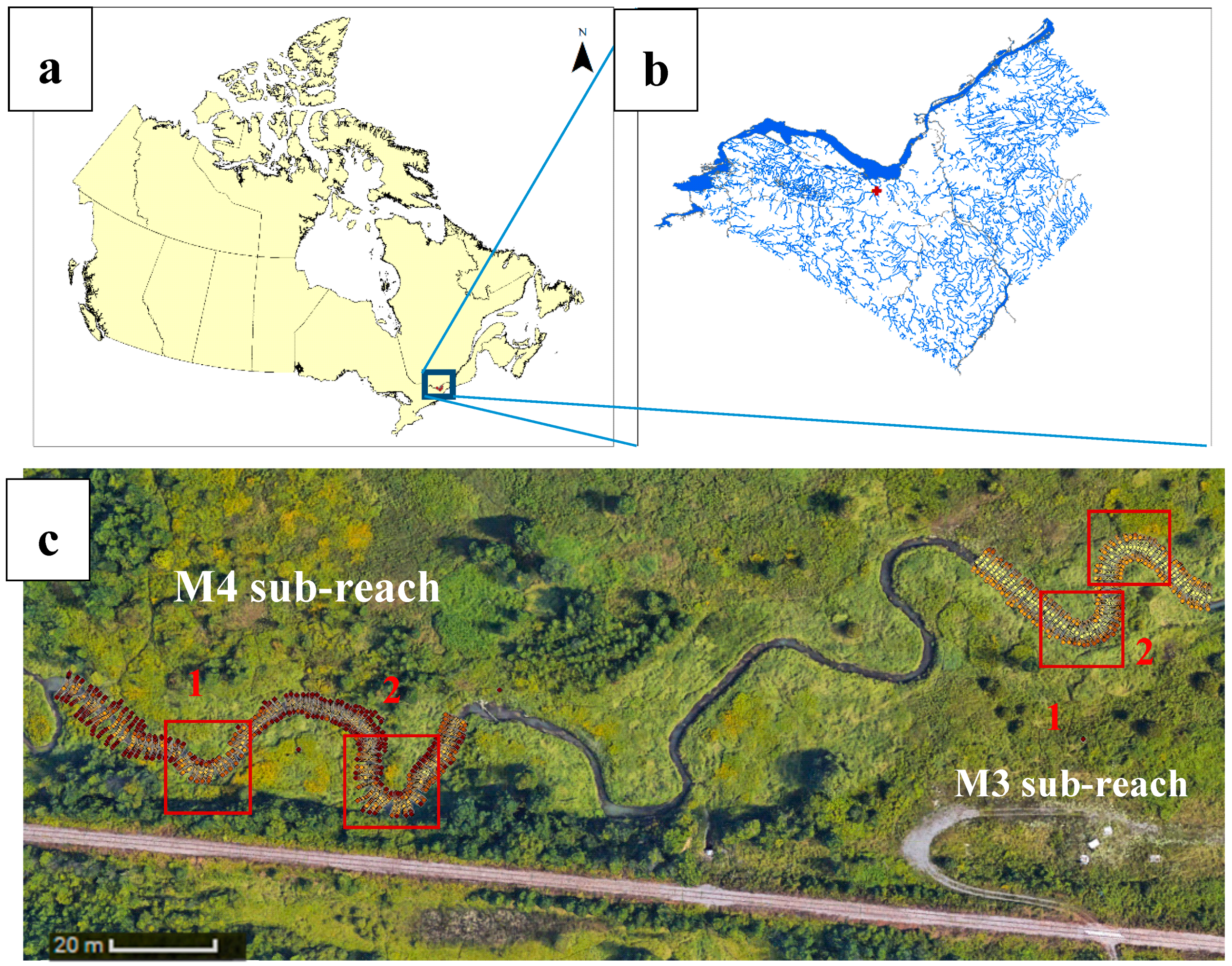


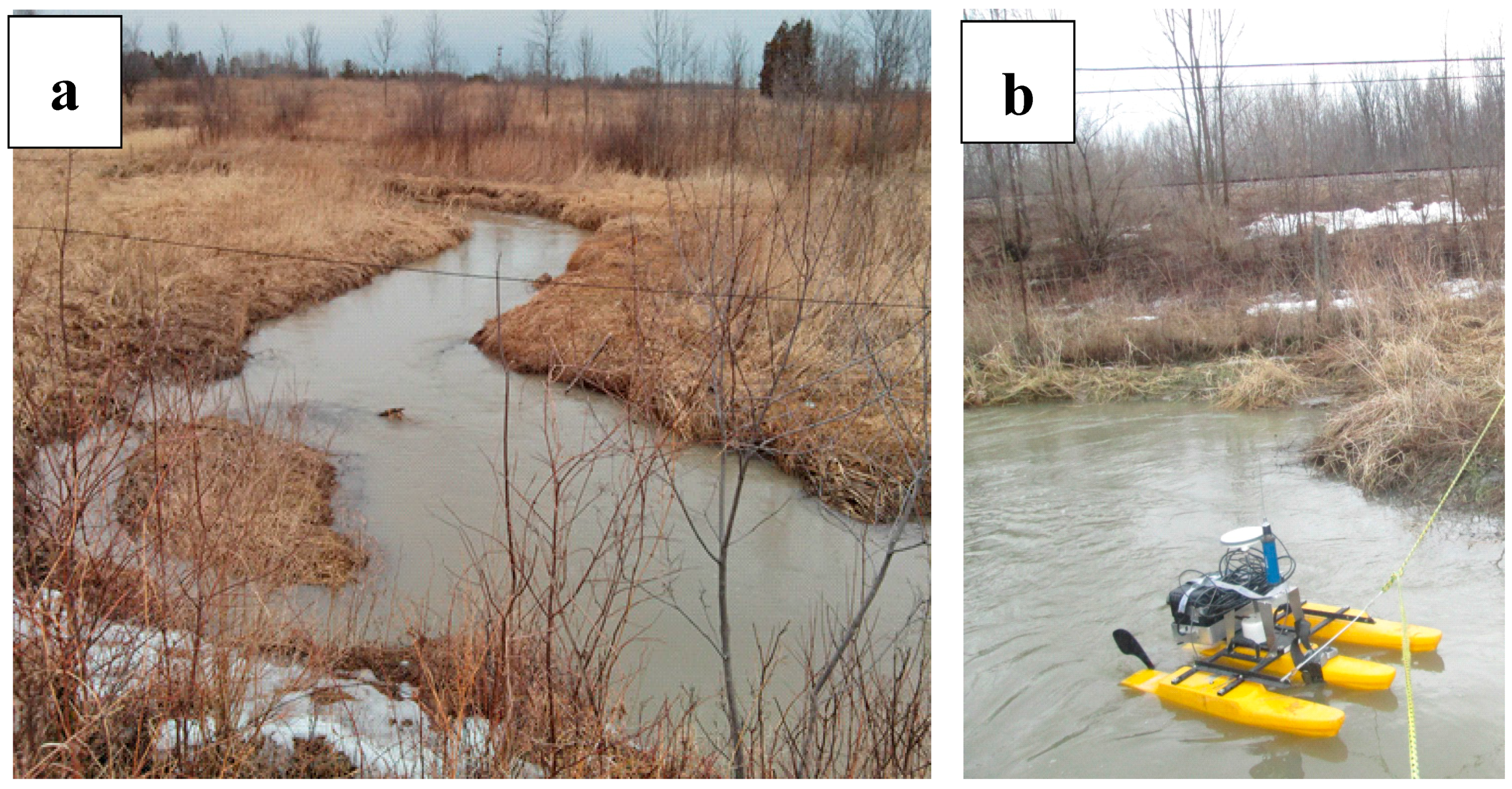
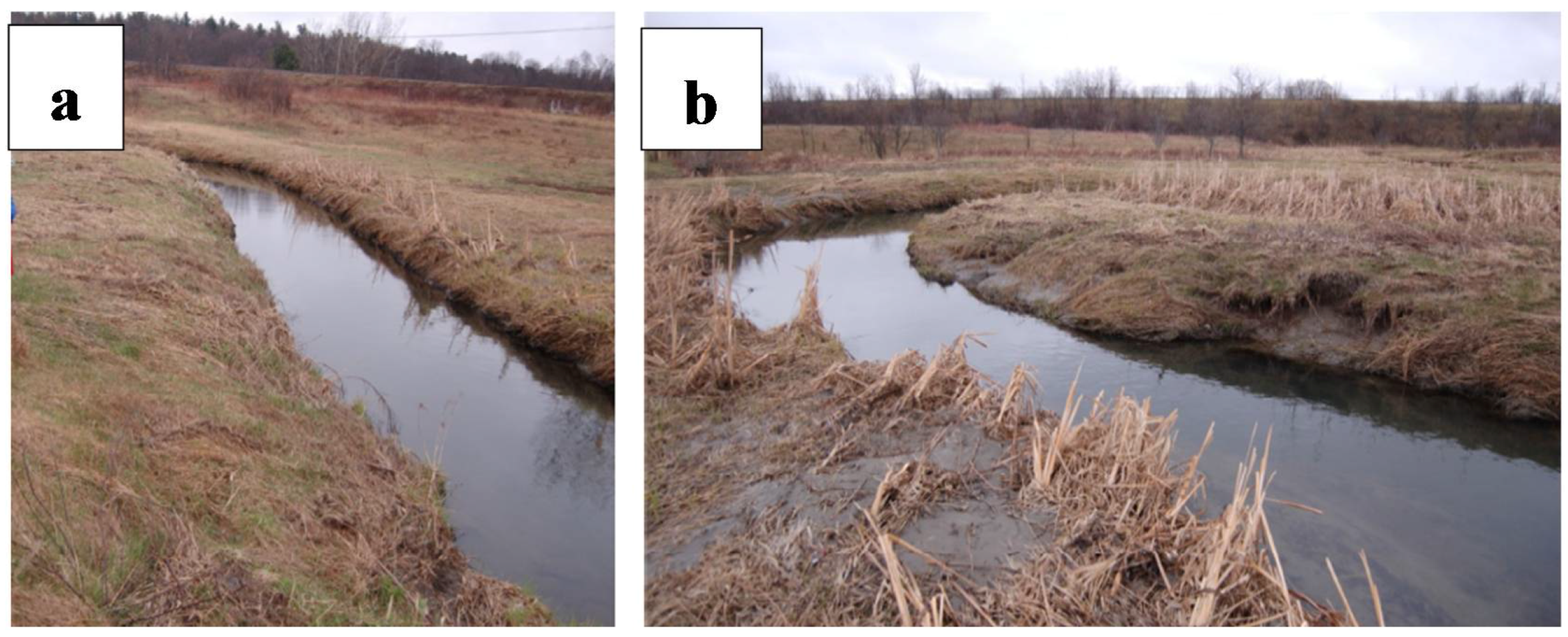
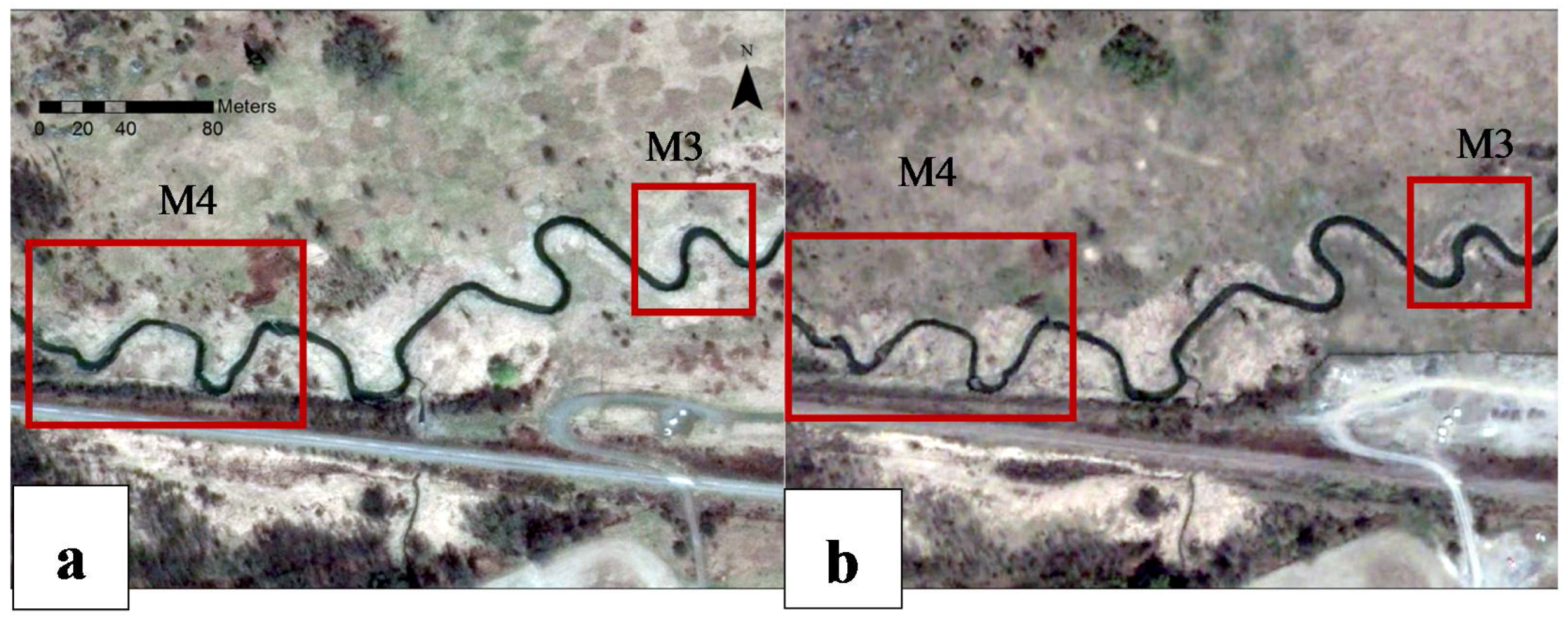
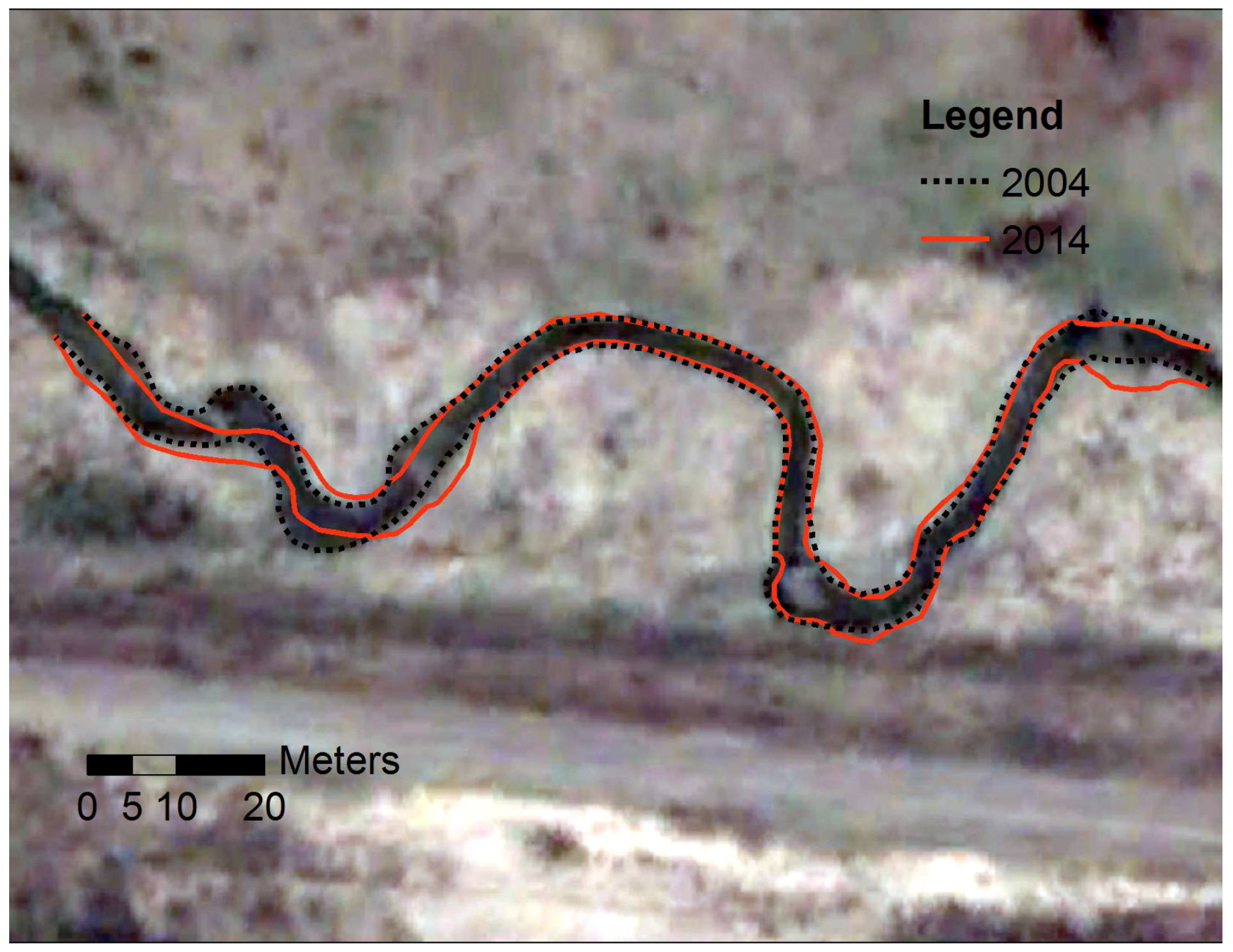
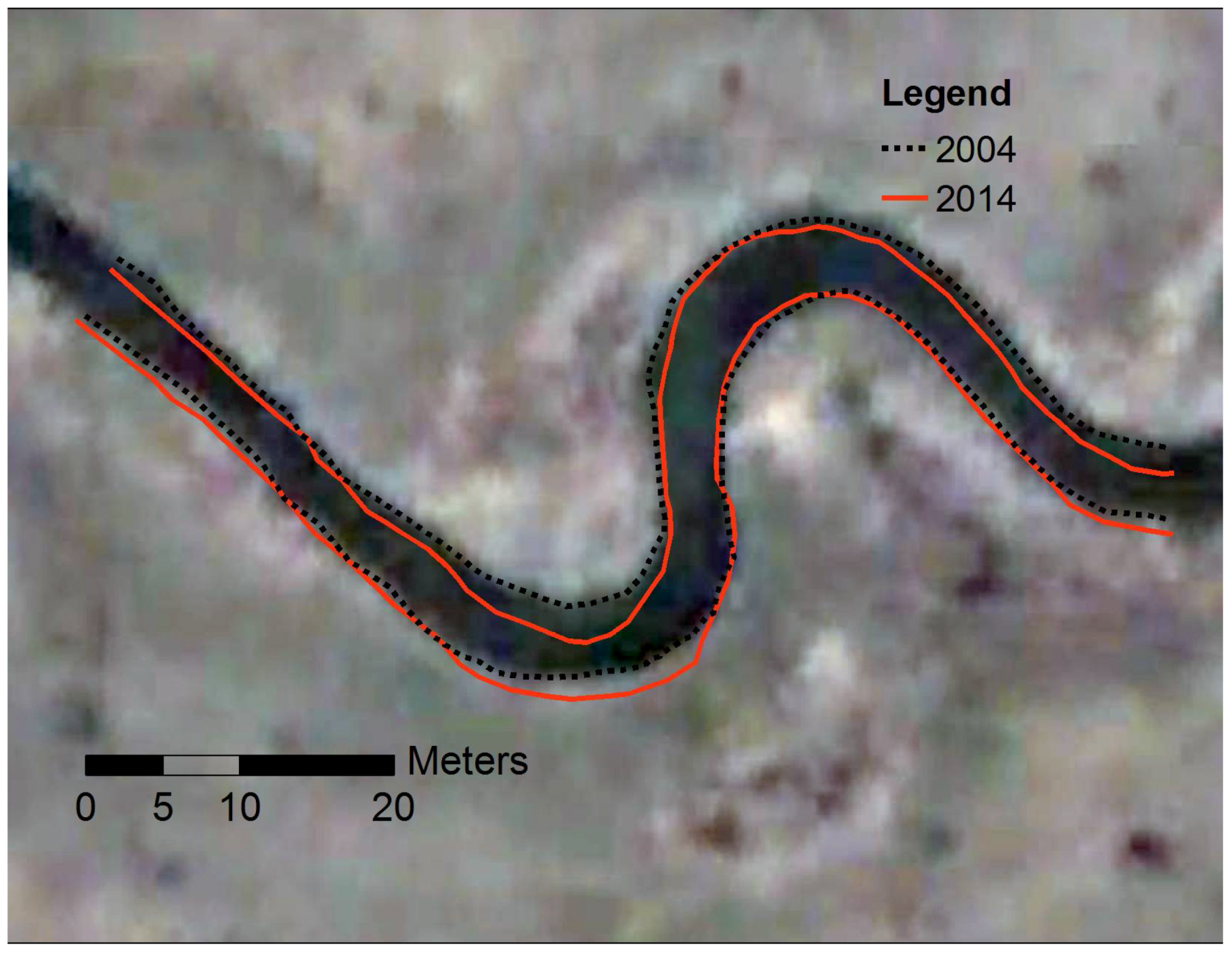
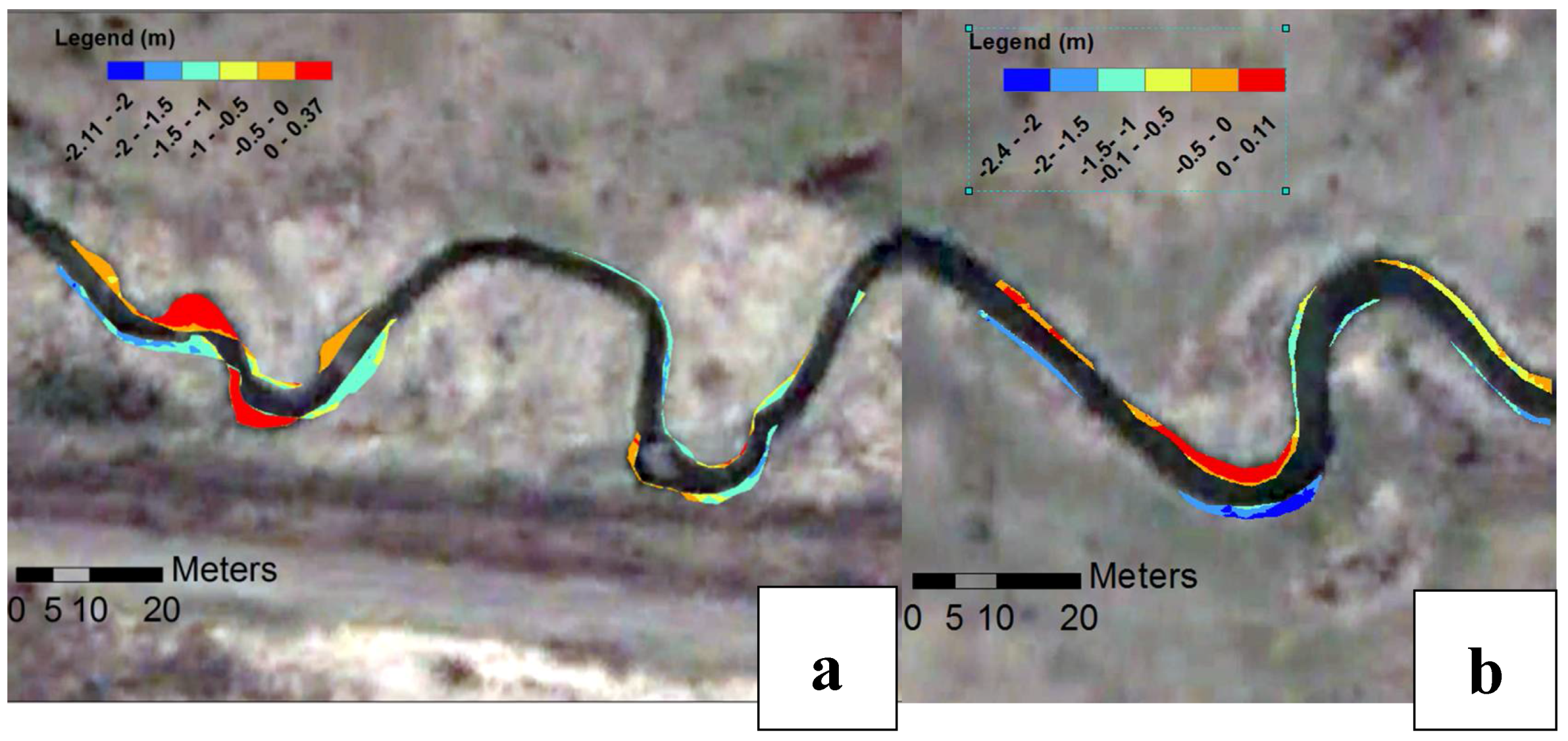
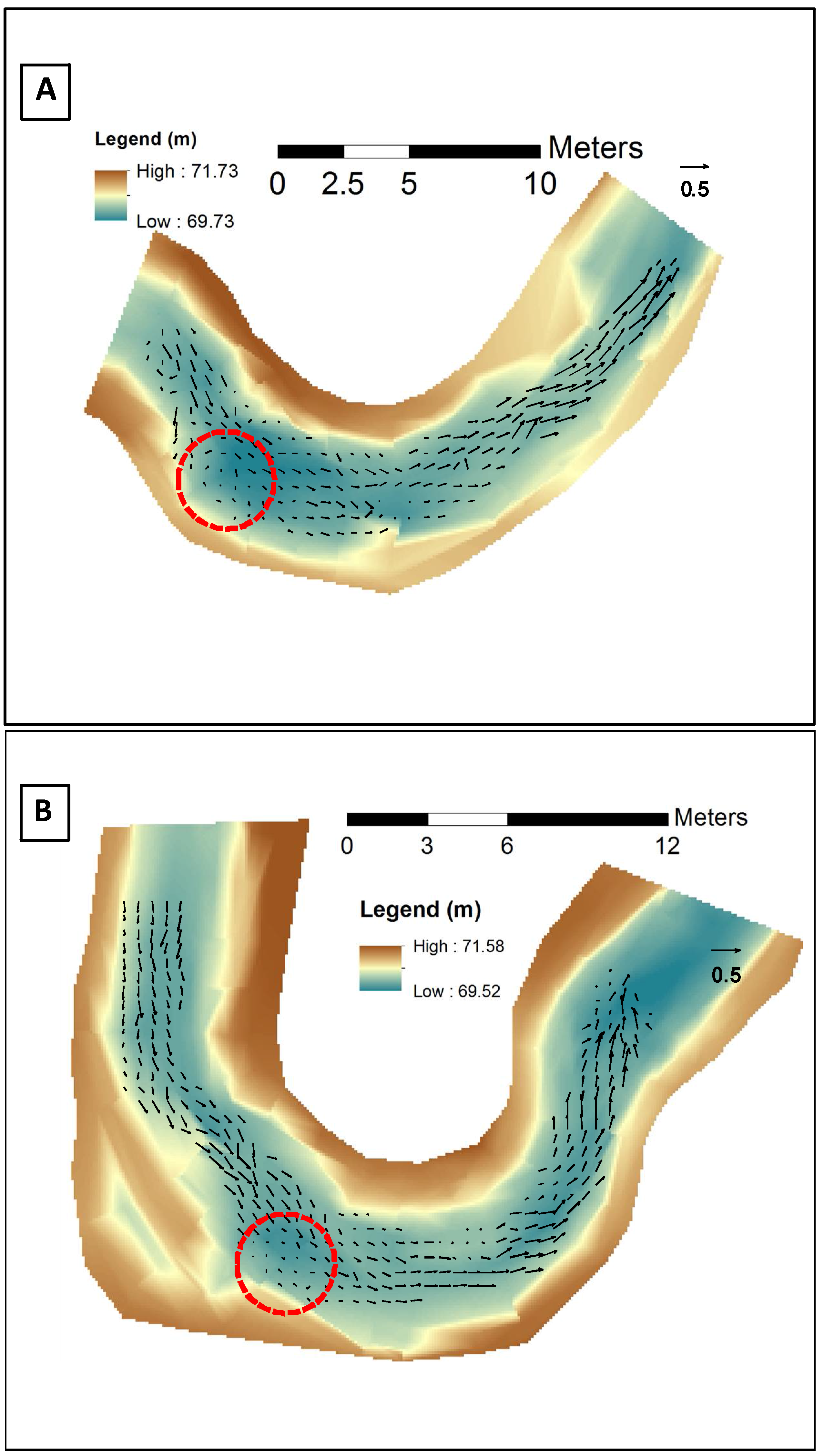

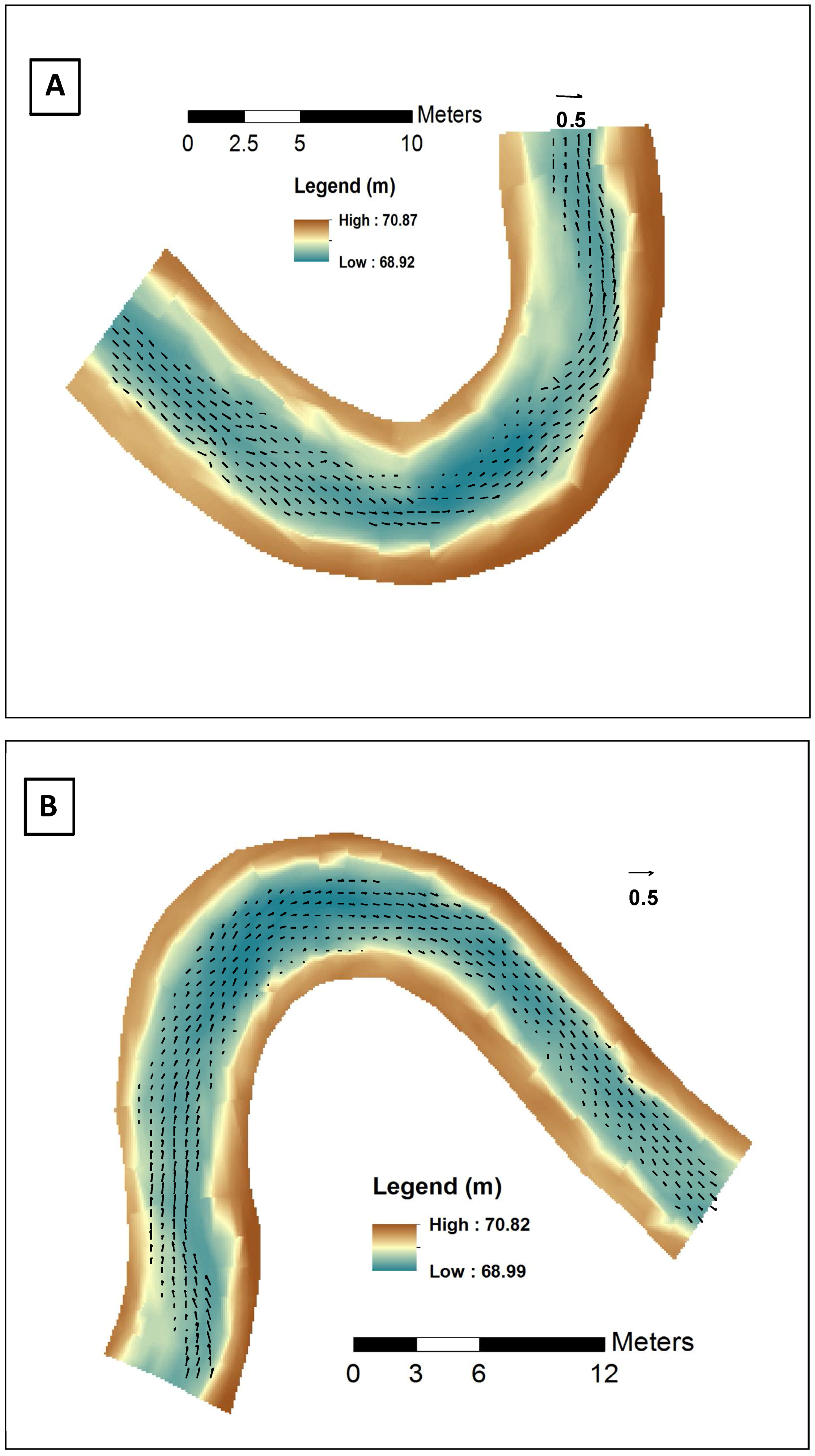
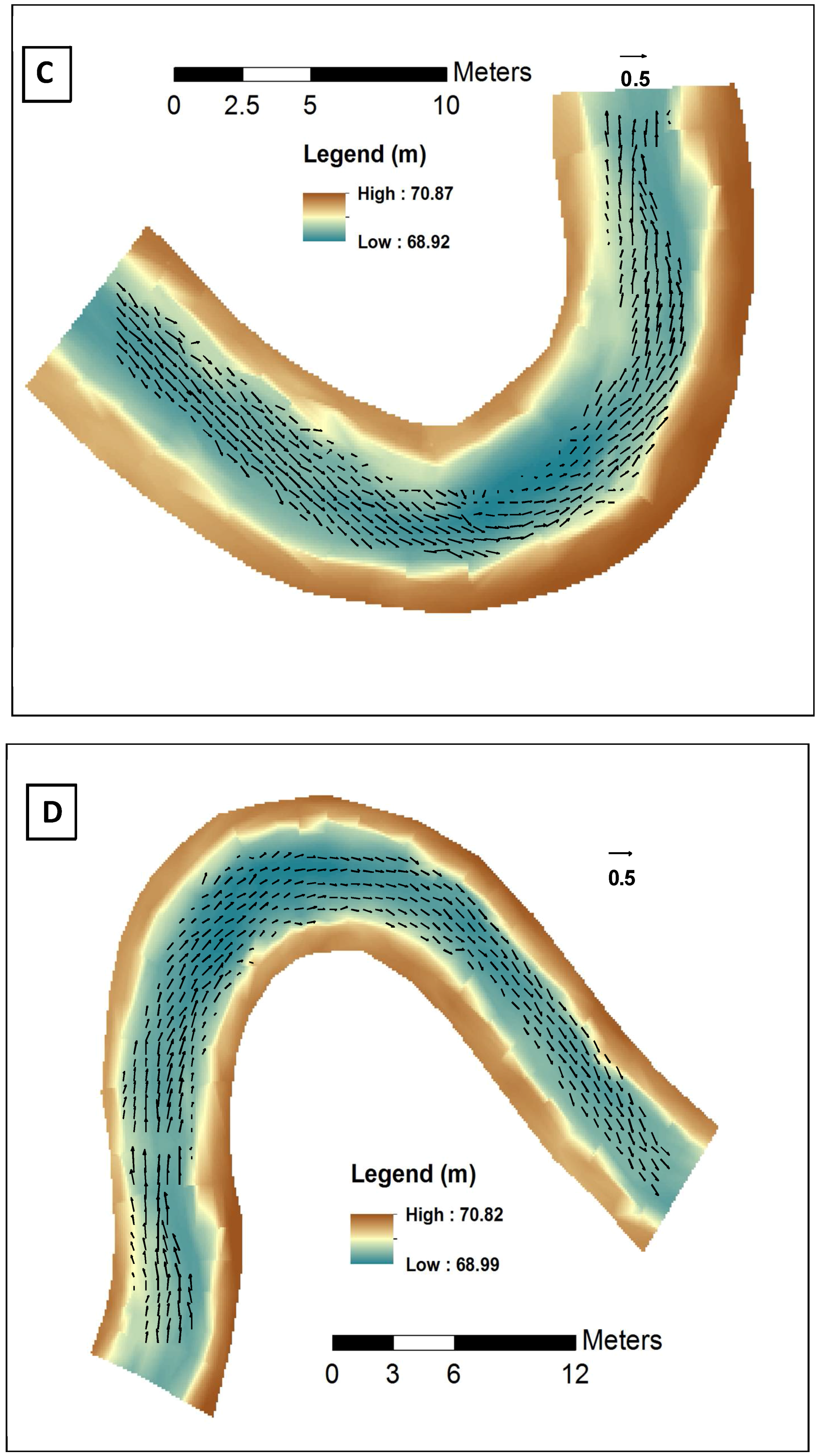
| Parameter | M4 Sub-Reach | M3 Sub-Reach |
|---|---|---|
| Channel slope | 0.0017 | 0.0016 |
| Averaged width (m) | 3.4 | 3.6 |
| Averaged depth (m) | 0.4 | 0.6 |
| Averaged discharge (m3/s) | 0.45 | 0.45 |
| Averaged flow velocity (m/s) | 0.2 | 0.17 |
| Average Froude number | 0.1 | 0.07 |
| Sampling Reach | Date | Length of the Channel Path (m) | Sinuosity |
|---|---|---|---|
| M4 | 2004 | 187.88 | 1.55 |
| 2014 | 175.27 | 1.49 | |
| M3 | 2004 | 106.26 | 1.44 |
| 2014 | 107.1 | 1.46 |
© 2018 by the authors. Licensee MDPI, Basel, Switzerland. This article is an open access article distributed under the terms and conditions of the Creative Commons Attribution (CC BY) license (http://creativecommons.org/licenses/by/4.0/).
Share and Cite
Parsapour-Moghaddam, P.; Rennie, C.D. Influence of Meander Confinement on Hydro-Morphodynamics of a Cohesive Meandering Channel. Water 2018, 10, 354. https://doi.org/10.3390/w10040354
Parsapour-Moghaddam P, Rennie CD. Influence of Meander Confinement on Hydro-Morphodynamics of a Cohesive Meandering Channel. Water. 2018; 10(4):354. https://doi.org/10.3390/w10040354
Chicago/Turabian StyleParsapour-Moghaddam, Parna, and Colin D. Rennie. 2018. "Influence of Meander Confinement on Hydro-Morphodynamics of a Cohesive Meandering Channel" Water 10, no. 4: 354. https://doi.org/10.3390/w10040354





